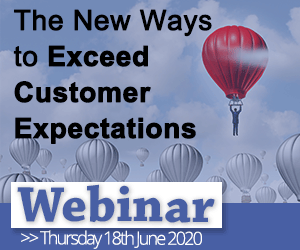Our panel of experts drill down on the contact centre technologies that can help exceed customer expectations.
1.Call-back solutions remove the need for the caller to queue
Call-back solutions offer an option of a call-back at a customer-defined time during peak periods. So, instead of waiting on the line, when a call goes to “hold” the call centre will phone the customer when they have reached the front of the queue.
Also, if the waiting time is too long and the customer has other duties to attend to, a time can be scheduled for whenever is best for the advisor to call back.
2. Use social media to find customer complaints

Mark Lockyer
Automatically delivering social posts and online interactions to contact centre advisors for response handling facilitates a true single view of the customer’s communication preferences.
By integrating the posts with any other channels that the customer has used, the advisor can see if the customer has engaged with the company in any other way and can also have access to any useful customer information when responding to their post.
With thanks to Mark Lockyer at IP Integration
3. Speech analytics can help identify advisor skill gaps

Lorne Wood
Using a sample of calls to conduct one-on-one coaching about advisor performance is an effective method to improve agent performance. However, speech analytics can measure script adherence and skills proficiency across all customer phone contacts, not just a small sample, and then automatically apply the same performance standard to all measured calls.
Advisor performance is then given scores for skill standards, on a specific scoring parameter that can be customised per project, line of business or agent group. These scores can then identify an advisor’s weaker skill areas, which can then be developed to improve their overall performance.
With thanks to Lorne Wood at Opentext WFO Software
4. Speech analytics enables you to spot dissatisfied customers

David Evans
Speech analytics allows an organisation to make sense of the millions of interactions taking place in the contact centre and identify issues that might threaten customer experience.
For example, a customer might mention a competitor’s product or offering being superior, or express their dissatisfaction with the service received. These calls are the perfect source of hidden insights that, if actioned appropriately, can significantly improve customer experience.
With thanks to David Evans at Business Systems
5. Speech analytics highlights staff training needs
With speech analytics in place, you have the ability to provide each advisor with a personalised scorecard that identifies their performance against a number of key criteria, such as empathy, that have been identified in delivering a successful call outcome. This root-call analysis allows you to categorise each type of call, provide direct and continuous performance feedback to advisors, and offer the advisor training opportunities that can ultimately lead to improved or exceeded customer experiences.

Maureen Szlemp
For example, if the analysis identifies a change in acoustics that suggests the call is deteriorating, a message can be sent to the advisor to adjust their vocal style. It can also alert a supervisor who could intervene if needed.
6. Interaction analytics identifies emerging trends across multiple channels
If there is a problem with a product and customers are tweeting about it, interaction analytics will be able to identify the emerging trend. This will enable you to predict the possible rise in call volumes to your customer centre and prepare your advisors with the right information beforehand to help ensure that they are delivering the best possible service to your customers.
With thanks to Maureen Szlemp at CallMiner
7. Cloud-based headset management tools increase vocal clarity

Richard Kenny
With a high number of important customer calls being taken at contact centres, it is essential that headsets are set up correctly in the environment they are being used in, especially when it comes to voice clarity.
Cloud-based headset management tools allow IT and contact centre managers to accurately schedule and deploy firmware updates whenever needed. This ensures that all headsets are in optimum condition and can cut out disruptive background noise. In turn, this allows employees to interact with customers with minimal interruption and provide a level of service far beyond expectations.
With thanks to Richard Kenny at Plantronics
8. Cloud technology provides interaction continuity
Consumers want continuity, whichever interaction method they choose. Using CRM-linked contact solutions can ensure that advisors are presented with historic information about a customer as soon as a call, email or webchat is received. This saves the customer from repeating their personal information and the inevitable frustration that causes.
The reduction in time wasted searching customer records makes for a more seamless experience for the customer.

Derwyn Jones
9. Call blending reduces queueing time
Call blending gives contact centres the flexibility to deliver both inbound and outbound calls seamlessly to appropriately skilled agents, based on call traffic at any time.
Using the dialler’s complex algorithms to adapt to the flow of call traffic dynamically enables contact centres to increase advisor productivity, by using the same teams to handle inbound and outbound calls, emails, and webchat and SMS interactions. This can help to improve customer service by reducing call queuing, and provides a more varied and interesting experience for the agent.
With thanks to Derwyn Jones at Ultracomms
10. Mobile IVR allows for customer self-service
Mobile IVR solutions navigate users through an organisation’s customer service options, effectively creating a highly visual and intuitive IVR-like experience. This enables customers to self-serve while making it easy for the business to push information back to them, thereby reducing customer effort and frustration.
Also, customers can see the menus and prompts instantly rather than waiting to hear them, allowing them to tap their way quickly through the menu levels and reduce overall interaction time.

Jeremy Payne
11. Show the advisor if the customer has changed channels
Businesses can make all interaction channels visible to an agent, who can then use the knowledge gained to deliver a better-informed, and therefore faster and more accurate, service to the customer. Key to this is integration between the contact centre solution and the CRM system. This provides the agent with instant access to customer data, enabling them to understand the interaction history and the status of specific engagements.
By linking the contact centre with unified communications tools like Skype for Business, the organisation can see who it has available to solve the customer’s problem and route calls through to that person, helping to exceed customer expectations by solving queries efficiently.
With thanks to Jeremy Payne at Enghouse Interactive
12. Skills-based call routing selects agents based on appropriate expertise

Neil Titcomb
Skills-based routing ensures that customer queries are prioritised and handled by the advisors best suited to resolve them.
Modern omnichannel platforms can dynamically route inbound requests through a multitude of touchpoints to the agents best placed to resolve them based on a number of factors, such as advisor skill-level, key knowledge areas, and channel experience.
With thanks to Neil Titcomb at Genesys
13. Advisor support technology optimises customer interaction

Nigel Dunn
Technology such as comfortable easy-to-use headsets offers optimal sound quality and ultra-noise-cancellation to block out the background noise that a customer might expect in a busy call centre. Such headsets are very good at reducing performance- and customer-focused pain points. This is especially the case if the headset is both lightweight and unobtrusive and allows contact centre workers to have lifelike conversations without unwanted distractions from colleagues.
In call-centric environments, it’s important that a set-up is established with conversation as the dominant work mode. By combining dedicated concentration zones with technology that promotes productivity, efficiency and confidentiality, high-quality customer service is far more likely to be delivered.
With thanks to Nigel Dunn at Jabra
14. Natural language processing provides instant service out of hours
Providing instant service out of hours is one way contact centres can stand out from the crowd and exceed expectations. With the use of advanced natural language processing (NLP) in automated email, chat and virtual assistants, customer service questions and complex requests can now be processed using automation for customers seeking assistance out of hours or when the agent lines are engaged.

Susannah Richardson
15. Artificial Intelligence (AI) processes requests and provides basic information
Artificial Intelligence (AI) can now recall orders and report on job status and stock levels and much more. Also, the technology can now categorise messages and break down the text into meaningful elements in order to detect cases that can be managed automatically. This goes beyond the pattern matching and keyword searching that customers have widely become accustomed to and exceeds expectations by progressing the query to the next level without human assistance.
With thanks to Susannah Richardson at mplsystems
16. Multichannel cloud contact centre solutions prevent the need for busy tones

Colin Hay
Multichannel cloud contact centre solutions provide agents with flexibility to respond to phone, email, web chat, social media and SMS enquiries all within one purpose built application and not a series of add-ons. Such flexibility means no more busy tones when all lines are in use and the ability to add additional agents as and when required, wherever they maybe.
This technology also allows customers to expect a fast response and first call resolution, whilst not having to repeat themselves several times to different people during the process.
With thanks to Colin Hay at Intelecom
17. Use social media to provide customers with around-the-clock support
Live updates are easily accessible and provide a proactive customer service approach and instant feedback. This means that customers are kept aware of any issues rather than having to contact the company and potentially wait in long inbound queues.
Using the open-book approach and ‘listening’ to any mentions/Tweets can also help to exceed customer expectations, as companies can display their willingness to go the extra mile in the public arena. Often witty or thoughtful responses can go viral, meaning that the company can reach a wider audience or following that they might not have reached otherwise.
18. Managing customer data offers customers a tailored experience
By managing customers’ data to provide a tailored experience, you can demonstrate that your company understands the requirements of each customer. You can do this by using a CRM package that gathers information such as an individual’s preferred method of contact or how they use the service. In doing so, you can streamline their requests in the future.
For example, if a customer regularly requests a taxi from their work on a Friday night, the company can learn this behaviour and send out a proactive text message, using their name to personalise the message. This message enquires if the customer would like to book the taxi that week, or if a further pick-up is required later in the day. Then, the IVR can automatically detect their response and see if they need to be picked up from the last location that they were dropped off at.
With thanks to Martyn King at Nexbridge
19. Gamification supplies agents with goals, feedback and rewards
Gamification applies video game mechanics in non-game contexts, and in business settings, it is generally used to engage employees and improve performance. For any gamification project to succeed, an organisation needs to align the goals of players with those of the business itself. Reliable and relevant metrics connected to the company’s top priorities helps to do this, by keeping management informed about ROI and performance.

Gil Trotino
When organisations get gamification right, the effect is powerful, with an average 25 percent increase in advisor productivity. This is because gamification provides advisors with goals, real-time feedback and rewards that matter, which transforms the performance of your organisation.
20. Voice of the customer programmes create processes on what customers tell you
Voice of the Customer (VOC) programmes are continuing to mature, so much so that some VOC solutions are receiving both direct and indirect feedback from their customers. This can be used to measure customer emotion and sentiment across multiple channels in real time.
By doing so, actionable data is collected and businesses can gain insights from the data for process change or intervention. So, processes can be designed to meet and then exceed the customer feedback that VOC has provided you with.
With thanks to Gil Trotino at NICE
21. Voice biometrics makes identifying yourself easier
Where customers really get excited is when organisations use technology to dramatically improve a routine process. For example, everyone gets bored when they have to go through the traditional verification procedure with their bank.
Introduce voice biometrics, however, and that entire process almost disappears – saving a lot of time and considerable effort. This is because voice biometrics can provide you with a vocal fingerprint, reducing the need for security questions, which the customer may easily have forgotten their answers to.

Stuart Dorman
22. Click-to-dial links increase efficiency
Contacting businesses through click-to-dial links on websites is a lot easier than navigating through traditional channels, and, thanks to technologies such as WebRTC, it works well.
You can also conduct a lot of your interactions with organisations via Facebook Messenger. Not organisation is getting this right yet, but a good example is when I asked LV= for a copy of my car insurance documents using Messenger. They arrived in my inbox within half an hour.
With thanks to Stuart Dorman at Sabio
Click here for our Top Tips for Exceeding Customer Expectations
What technology have you introduced to help exceed customer expectations in your contact centre?
Put your thoughts in an email to Call Centre Helper.
Author: Charlie Mitchell
Published On: 2nd Nov 2016 - Last modified: 18th Oct 2024
Read more about - Technology, Business Systems, CallMiner, Colin Hay, Customer Expectations, Editor's Picks, Enghouse Interactive, Genesys, IFS, IP Integration, Jabra, Jeremy Payne, Neil Titcomb, Nexbridge, NICE, OpenText, Poly, Puzzel, Richard Kenny, Sabio, Susannah Richardson, Ultra




















